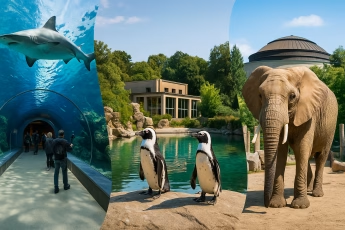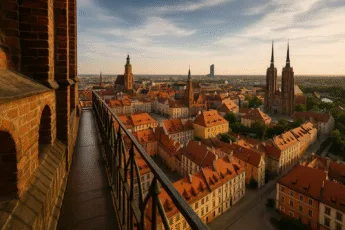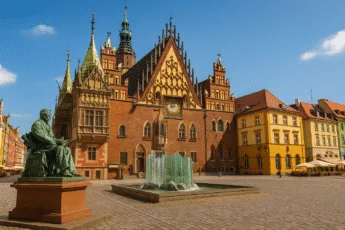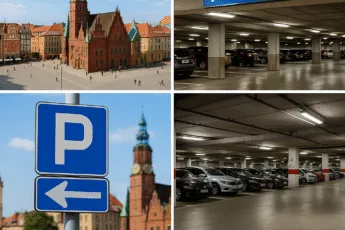- The role of Centennial Hall in the city layout
- How the area functions on an ordinary day
- Event days vs. everyday reality
- What really affects visitor comfort
- Centennial Hall as part of a larger complex
- Access and orientation
- Seasonality and annual rhythm
- How to plan your visit
- FAQ – Centennial Hall in Wrocław
Centennial Hall (Hala Stulecia) in Wrocław is not only an architectural landmark and a UNESCO World Heritage Site, but above all a functioning events venue used throughout the year. It operates as a large, multi-purpose arena for concerts, trade fairs, conferences and sporting events, set within a spacious complex of exhibition grounds, green areas and recreational zones.
The role of Centennial Hall in the city layout
In practical terms, Centennial Hall is one of the key focal points of eastern Śródmieście. For both residents and visitors, it serves as:
- a venue for large-scale events – concerts, performances, trade fairs and sports competitions;
- a reference point in the area of the Zoo, the Japanese Garden and Szczytnicki Park;
- a natural transport node – the “Centennial Hall” stop served by several tram and bus lines;
- the starting or finishing point of walks along the Pergola, near the Multimedia Fountain or further into the park avenues.
Its UNESCO status attracts organised groups, school trips and conference participants throughout the year, which directly influences crowd levels and traffic intensity at specific times and on certain days.
How the area functions on an ordinary day
Outside of major event days, the surroundings of Centennial Hall remain relatively calm. The building itself becomes more of a visual backdrop than a primary destination. Most people use the surrounding space: the Pergola, the Multimedia Fountain, nearby benches and green areas, treating the hall as a distinctive element of the landscape.
On weekdays, especially in the morning and early afternoon, the area is mainly used by local residents, runners and cyclists, as well as people heading to smaller events or to the Congress Centre. Pedestrian flow is dispersed, and moving between the hall, the Pergola and Szczytnicki Park is generally comfortable and unhurried.
On days without mass events, the immediate vicinity of the hall can feel surprisingly quiet compared to its atmosphere during major concerts or trade fairs.
Event days vs. everyday reality
The character of the space changes dramatically on days with large-scale events. The entire area then functions as logistical infrastructure for several or even tens of thousands of people arriving and leaving within a short time frame.
A typical event-day pattern includes:
- Afternoon: a noticeable increase in car traffic and public transport usage.
- Before the event: growing crowds near entrances, queues at security checkpoints, visible presence of staff and security services.
- After the event: intense pedestrian flow towards tram and bus stops, and temporary congestion on nearby roads.
As a result, the same space can feel either calm and comfortable or densely crowded, depending entirely on the event schedule.
What really affects visitor comfort
The overall experience around Centennial Hall depends on several repeatable factors worth considering:
- Event calendar – the primary driver of crowd size, queue length and parking availability.
- Time of day – mornings tend to be calmer, while evenings draw more people to the Pergola and fountain.
- Season – fountain shows run from late spring to autumn; winter sees far less recreational use.
- Weather – limited natural shade and shelter make conditions more demanding on hot, windy or rainy days.
- Logistics – chosen transport method and walking distances between the hall, the Zoo, Japanese Garden and park areas.
Being aware of these factors usually has a greater impact on comfort than the time of year itself.
Centennial Hall as part of a larger complex
Centennial Hall does not operate in isolation. It forms a coherent whole with the exhibition grounds, Pergola, Multimedia Fountain, the Iglica (spire), the Four Domes Pavilion and Szczytnicki Park. In practice, most visitors use the area in one of three ways:
- Event + walk – attending a concert, fair or match combined with a short stroll around the Pergola.
- Family outing – visiting the Zoo and gardens, resting by the fountain, possibly ending with an evening show.
- Relaxed park walk – passing through the area as part of a longer route across Szczytnicki Park.
What matters, therefore, is not only what happens inside the hall, but how the entire complex functions as a single urban recreational and event zone.
Access and orientation
Centennial Hall is well connected with the rest of the city. The “Centennial Hall” stop is served by tram lines 1, 2, 4, 10 and 19 and bus lines 145 and 146. During the summer season, Wrocław Tourist Lines also operate in this area.
| Mode of access | Regular day | Major event day |
|---|---|---|
| Car and on-site parking | Usually convenient, though busy on sunny weekends. | Parking fills quickly; expect longer walking distances. |
| Tram | Fast and predictable from the city centre. | More crowded but still the most reliable option. |
| Bus | Good coverage from eastern districts. | Possible delays after major events. |
| On foot | Pleasant walk from the Zoo or Japanese Garden. | Slower movement in dense crowds. |
Seasonality and annual rhythm
Centennial Hall operates year-round, but the surrounding space is most active from late spring to autumn, when the Multimedia Fountain shows and outdoor events dominate the area. Evenings can be particularly busy, especially during weekends and warm weather.
In winter, the area takes on a more local character and becomes noticeably calmer, making it a suitable time for visitors who prefer a quieter atmosphere and unobstructed walking space.
How to plan your visit
- For a peaceful walk: choose weekdays and morning hours.
- For major events: arrive early and use public transport.
- With children: combine the visit with the Zoo or Japanese Garden.
- If sensitive to noise and crowds: avoid peak event dates and fountain show evenings.
With the right approach, Centennial Hall becomes not just a landmark to “see”, but a functional and predictable part of the city that can be experienced on your own terms.







